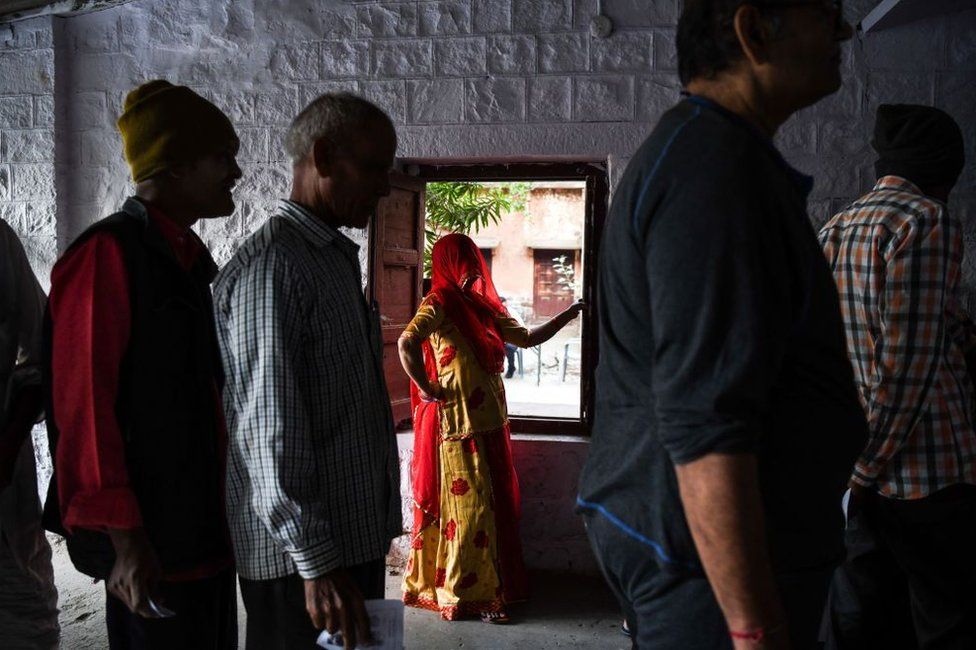India election 2019: The mystery of 21 million 'missing' women voters
- Published

Indian women got the right to vote the year their country was born. It was, as a historian said, a "staggering achievement for a post-colonial nation". But more than 70 years later, why are 21 million women in India apparently being denied the right to vote?
It is one of India's many social riddles.
Women have been enthusiastic voters in India: voter turnout among women will be higher in this year's general election than that of men. Most women say they are voting independently, without consulting their spouses and families.
To make them secure, there are separate queues for women at polling stations and female police officers guarding them. Polling stations contain at least one female officer.
More than 660 women candidates contested the 2014 elections, up from 24 in the first election in 1951. And political parties now target women as a separate constituency, offering them cheap cooking gas, scholarships for studies and bicycles to go to college.
'Major problem'
Yet, a truly astonishing number of women - equal to the population of Sri Lanka - appear to be "missing" from India's voters lists.
In their upcoming book, The Verdict: Decoding India's Elections, poll experts Prannoy Roy and Dorab Sopariwala find that the available data on women points to this.
They looked at the number of women above the age of 18 in the census, extrapolated it, and compared it to the number of women in the latest list of voters. And they found a sizeable "shortfall" - 21 million to be exact - in the number of female voters.
Three states - Uttar Pradesh, Maharashtra and Rajasthan - accounted for more than half of the missing female voters. Southern states such as Andhra Pradesh and Tamil Nadu fare better.
What does this mean?
More than 20 million missing women, analysts say, translates into 38,000 missing women voters on average in every constituency in India. In places like Uttar Pradesh, India's most populous and a key bellwether state, the figure swells to 80,000 missing women in every seat.
Given that more than one in every five seats are won or lost by a margin of fewer than 38,000 votes, the missing women could swing the results in many seats. The absence of a large number of women also means that India's electorate would be higher than the 900 million people who are eligible to vote in the summer elections. If the sex ratio in a constituency is skewed against women and the average voter is male, the preferences of female voters are likely to be ignored.
"Women want to vote, but they are not allowed to vote. This is deeply worrying. It also raises a lot of questions. We know that there are some social reasons behind this problem. But we also know that by controlling turnouts you can control results. Is that one of the reasons? We really need to investigate further to get to the truth," Prannoy Roy told me.
Read more from Soutik Biswas
With a sex ratio that is skewed in favour of men, India has had a problem of missing women for a long time.
Last year, a government report found that 63 million women were "missing" from India's population because the preference for sons led to sex-selective abortions and more care was given to boys. Separately, economists Shamika Ravi and Mudit Kapoor estimated that more than 65 million women - some 20% of the female electorate - were missing. This included women who were not registered to vote and women "who were not in the population because of gross neglect" (worsening sex ratio, which reflected the gross neglect). So elections, they said, were "revealing the preferences or the will of a population that is artificially skewed against women".
It's not that election authorities haven't worked hard to get more women to vote.
The Election Commission adopts a rigorous statistical method - gender ratios, elector-population ratios and ages of voters - to make sure that eligible voters are not left out. There is doorstep verification of voters and a substantial number of officials involved in this exercise are women. In villages, child welfare workers and women's self-help groups are roped in. State-run TV and radio programmes motivate women to register. There are even polling stations dedicated exclusively to women.
So why are so many women still missing from the rolls? Is it because many women shift residence after marriage and fail to register anew? (Less than 3% of Indian women aged 30-34 are single.) Is it because families still refuse to provide photographs of women to officials to publish in voters lists? Or does this exclusion have something to do with the "dark arts of voter suppression"?
"There is some social resistance, but it doesn't explain such large scale exclusion," says Dr Roy.
People who have helped organise elections in India say there is no reason to panic. Former election commissioner SY Quraishi told me that the enrolment of women had gone up steadily over the years. "There is social resistance to enrolling women still," he says.
"I have heard of parents not registering their daughter because they don't want to reveal her age, because they feel it will end up hurting their prospects for marriage. We have also been sometimes indifferent in our outreach to rope in more women voters," he said.
With the 2019 elections barely a month away, there's no time to fix this problem. Dr Roy believes there's only one way out - to let women vote even if they are not registered.
"Any woman who comes to a polling station and wants to cast her vote, and can prove she is 18 years old, must be allowed to vote," he says.
- Published10 April 2019
- Published25 January 2019
- Published6 March 2019
- Published15 October 2015